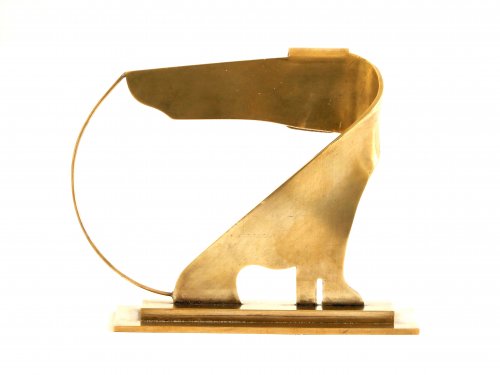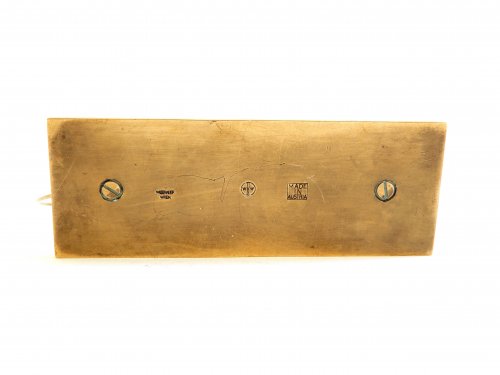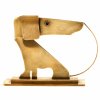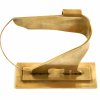Franz Hagenauer (1906-1986), Wiener Werkstätte Hagenauer Sitting dachshund
About this piece
A beautiful design by Franz Hagenauer, this sitting dachshund. It is so nicely stylized and a relatively rare work by the Viennese sculptor and metal artist.
In my eyes it is just like a puppy, but is that also intended?
The dachshund is made of a thick plate of brass where he has cut out and partly bent the brass plate. By adding a few accents, like eyes and a tail he transformed the two-dimensional plate into a three-dimensional sculpture.
He made several animal figures using this technique, all around 1945. The collection of Hagenauer is sometimes difficult to date. In my search I only find a few examples, most of them dated in 1945. The few examples I saw are not all exactly the same, sometimes the eyes or tail are slightly different. The details are handmade. From this little dog is also a larger size made.
His work is always special, he was early on in his career already a Modernist, he was always one step in front of the common movements in his designs. He has his own recognizable style. His figures have elan, artistry and always very stylized, often in angular lines. But there is more, there is always room for air, a certain lightness, often his figures amuses the viewer. So does this little dog.
The dachshund is signed on the bottom with: 'Hagenauer Wien', 'Made in Austria' and the well-known logo and hallmark of the Wiener Werkstätte Hagenauer 'WHW'.
Biography:
The name of Franz Hagenauer (Vienna, 1906-1986) is inextricably linked to his older brother Karl (1898-1956) and the Wiener Werkstätte Hagenauer, which his father Carl founded in 1898. Carl Hagenauer( 1872-1928) made all kind of little bronzes, like figures, animals and all kind of decorative items, but also consumer goods.
At a young age he sent his sons, both talented, to Franz Cisek's youth courses at the Kunstgewerbeschule, the Art Acadamy of Apllied Arts in Vienna. Both followed their training there, Karl studied architecture with Josef Hoffmann and Oskar Strnad. Franz studied sculpture with Anton Hanak and Josef Hoffmann. He also did an internship with Dagobert Peche at the Wiener Werkstätte.
Franz was regarded more as the artist and intellectual of the family, although Karl was very talented in design and drawing, he also had good skills for business and immediately went to work at the family business, after his father died in 1928, he took over the lead.
Both brothers designed for the firm, they were closely associated with the Wiener Werkstätten, whose influence was large. Artists such as Otto Prutscher, Josef Hoffmann and F.J. Merkel, designed for Hagenauer Werkstätte.
In 1930 Julias Jirasek (1896-1966) was also hired, just like Karl he had followed his training at the Academy with Oskar Strnad.
The brothers used various materials for their sculptures and decorative objects such as mirrors and candlesticks, first mainly bronze and brass, later also in wood, nickel-plated metal, silver and even ivory.
They exhibited at various Work Exhibitions and received several prizes, such as in London, Monza and Paris in 1925. The received a lot of international recognition and buyers.
Franz designed dancers, athletes, animal figures but also male/female figures, special busts and masks, all very stylized. He continued to make bigger work, even man-sized figures at the end of his long career.
Franz Hagenauer also taught at the Wiener Kunstgewerbeschule in free design and metal art.
After Franz's death in 1986, The Hagenauer Werkstätte also closed its doors.
The designs and sculptures of Karl and Franz Hagenauer are still in high demand. Their work makes part of many Museum collections.
In Vienna, the Hagenauer Werkstätte is considered of great importance and seen as a representation of the Viennese Arts & Crafts.
Literatuur:
- Alistair Duncan; 'Art Deco Sculpture', Thames & Hudson, London 2016. P. 258-265.
- Christian Brandstätter, Daniela Gregori, Rainer Metzger; 'Wenen 1900', Librero 2018, p.266-269, 462 en 463. (Oorspronkelijke titel 'Vienna 1900 Complete', Thames $ Hudson, 2018.)
- 'Modern work of Metallwork', Bröhan Museum Berlin, 1990. P. 510-517.
Condition
Very good, just the normal traces of use and age.
Material:
Brass
Measurements:
Width: 11,5 cm
(4,53")
Height: 10,7 cm
(4,21")
Depth: 4 cm
(1,57")
Year:
approximately 1945
Origin:
Vienna, Austria
Artist / atelier:
Franz Hagenauer, Wiener Werkstätte Hagenauer







